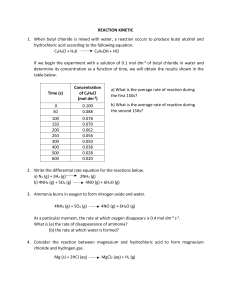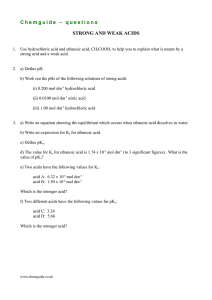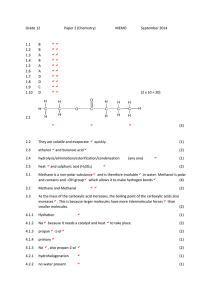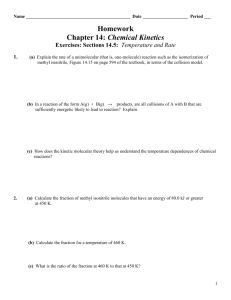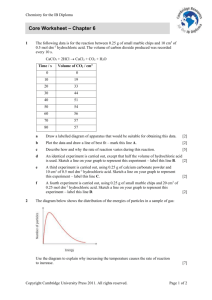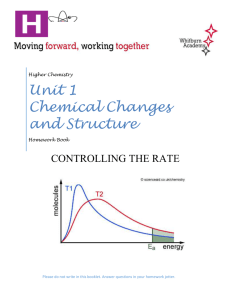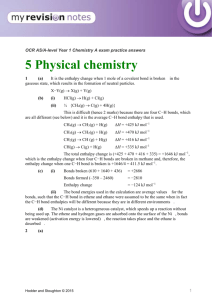TIER 4
advertisement
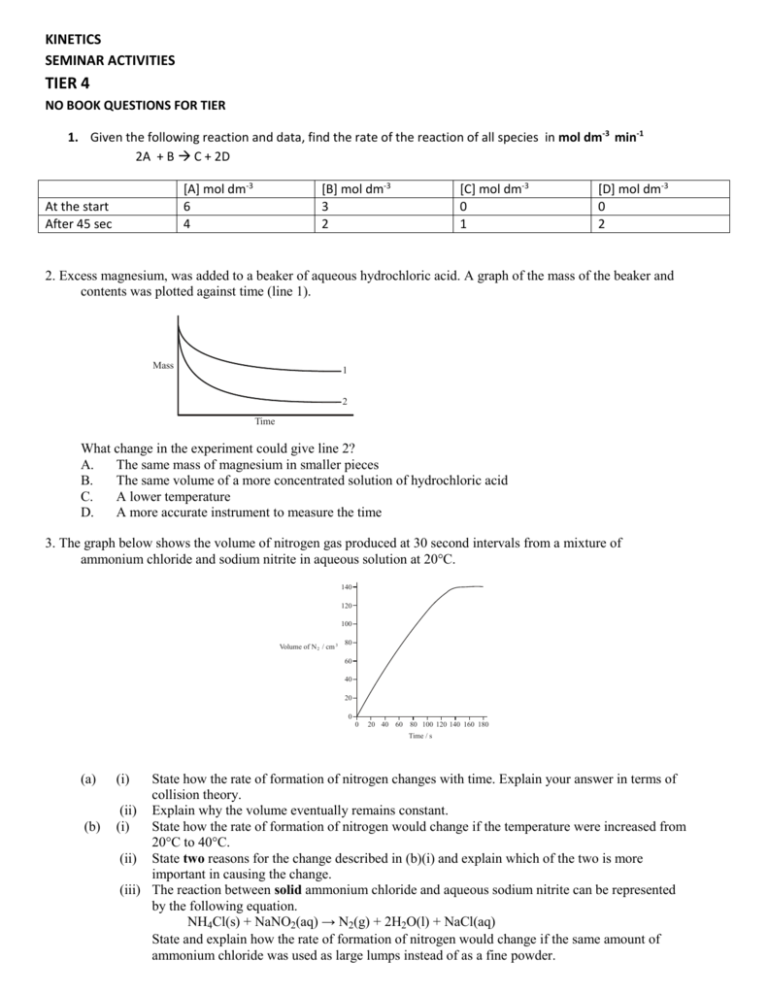
KINETICS SEMINAR ACTIVITIES TIER 4 NO BOOK QUESTIONS FOR TIER 1. Given the following reaction and data, find the rate of the reaction of all species in mol dm-3 min-1 2A + B C + 2D [A] mol dm-3 6 4 At the start After 45 sec [B] mol dm-3 3 2 [C] mol dm-3 0 1 [D] mol dm-3 0 2 2. Excess magnesium, was added to a beaker of aqueous hydrochloric acid. A graph of the mass of the beaker and contents was plotted against time (line 1). Mass 1 2 Time What change in the experiment could give line 2? A. The same mass of magnesium in smaller pieces B. The same volume of a more concentrated solution of hydrochloric acid C. A lower temperature D. A more accurate instrument to measure the time 3. The graph below shows the volume of nitrogen gas produced at 30 second intervals from a mixture of ammonium chloride and sodium nitrite in aqueous solution at 20°C. 140 120 100 Volume of N 2 / cm 3 80 60 40 20 0 0 20 40 60 80 100 120 140 160 180 Time / s (a) (b) (i) State how the rate of formation of nitrogen changes with time. Explain your answer in terms of collision theory. (ii) Explain why the volume eventually remains constant. (i) State how the rate of formation of nitrogen would change if the temperature were increased from 20°C to 40°C. (ii) State two reasons for the change described in (b)(i) and explain which of the two is more important in causing the change. (iii) The reaction between solid ammonium chloride and aqueous sodium nitrite can be represented by the following equation. NH4Cl(s) + NaNO2(aq) → N2(g) + 2H2O(l) + NaCl(aq) State and explain how the rate of formation of nitrogen would change if the same amount of ammonium chloride was used as large lumps instead of as a fine powder. TIER 5 BOOK QUESTIONS HL: IN CHAPTER #1,2,9 SL IN CHAPTER #1 PAGE 126-128 #1,4,6,10 ACTIVITY: 1. Describe how the probability density vs speed of the different noble gases differ in the graph below. Explain why this trend occurs with the noble gases 2. Which quantities in the enthalpy level diagram are altered by the use of a catalyst? Enthalpy I II III Time A. B. C. D. I and II only I and III only II and III only I, II and III 3. The rate of a reaction between two gases increases when the temperature is increased and a catalyst is added.Which statements are both correct for the effect of these changes on the reaction? Increasing the temperature Adding a catalyst A. Collision frequency increases Activation energy increases B. Activation energy increases Activation energy does not change C. Activation energy does not change Activation energy decreases D. Activation energy increases Collision frequency increases 4. The graph below shows the volume of carbon dioxide gas produced against time when excess calcium carbonate is added to x cm3 of 2.0 mol dm–3 hydrochloric acid. Volume of CO 2 Time (i) (ii) Write a balanced equation for the reaction. State and explain the change in the rate of reaction with time. Outline how you would determine the rate of the reaction at a particular time. (iii) Sketch the above graph on another paper. On the same graph, draw the curves you would expect if: I. the same volume (x cm3) of 1.0 mol dm–3 HCl is used. II. double the volume (2x cm3) of 1.0 mol dm–3 HCl is used. Label the curves and explain your answer in each case. TIER 6 BOOK QUESTIONS HL: IN CHAPTER #4,10 SL: IN CHAPTER #4 PAGE 127-127 #8, 11 1. Which quantities in the enthalpy level diagram are altered by the use of a catalyst? Enthalpy I II III Time A. B. C. D. I and II only I and III only II and III only I, II and III 2.Design and perform an experiment using the materials given to show how the rate of a reaction can be increased. Graph the results showing a base line and a line showing what feature you changed.
